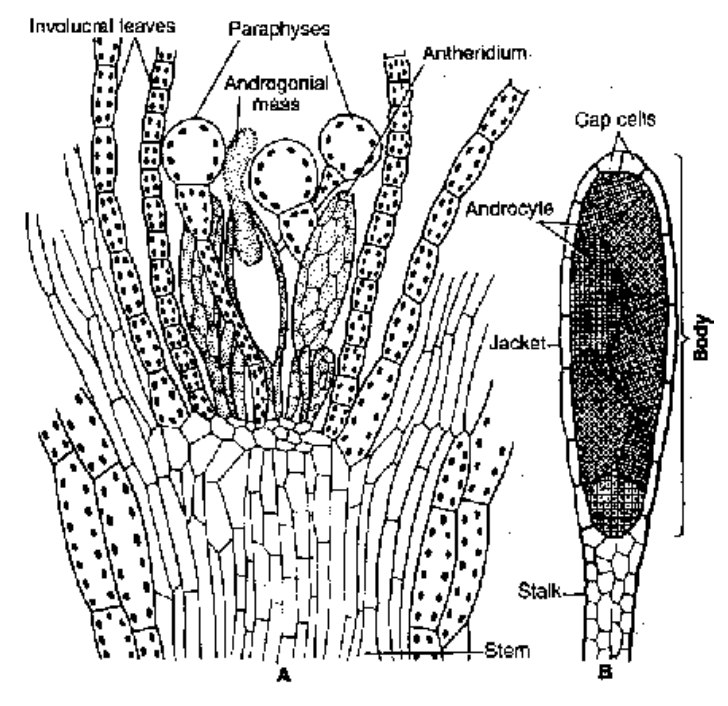Funaria
Plant Kingdom of Class 11
About Funaria
Occurrence : Gregarious in habit, growing in moist and shady places.
Plant body : Foliose, ie erect leafy gametophyte (adult plant body). Though juvenile stage is represented by protonema.
Most common species is Funaria hygrometrica.
Adult plant body is differentiated in to root like stem like and leaf like structures called as rhizoid, cauloid and phylloid respectively.
Rhizoids multicellular, branched, septate and with oblique septa.
Leaves sessile, with a mid rib.

Funaria hygrometrica : A female branch of leafy gametophore with sporophyte B. A leafy gametophore with a male branch and a female branchwith young sporophyte
Reproduction
Vegetative : Takes place by bulbils, gemma, apospory and fragmentation, by primary and secondary protonema.
Sexual : Plants are monoecious and autoecous.
Antheridia develop in clusters on male branch (main axis) and surrounded by a whorl of leaves called perigonial leaves and separated by sterile hair called paraphyses.
Paraphysis protect the young antheridia from dessication.
Each antheridium produces numerous coiled biflagellated antherozoids.
The archegonial group borne on female branch (lateral branch)
It is also surrounded by whorl of leaves called perichaetial leaves.
Each archegonium is flask shaped with a swollen venter and a long twisted neck. Neck has 6-10 neck canal cells and venter has a venter canal cell and a large egg cell.
Water is essential for fertilisation. At maturity all the neck canal cells and venter canal cell disintegrate to produce nucilage, which attract the antherozoids chemotactically.
The anthorozoid fertilizes the egg resulting in the formation of diploid zygote (2n).

Moss : (A) L. S. of antheridial head, (B) L.S. of one antheridium (young stage)

Moss : (A) L.S. of archegonial head, (B) One archegonium
Sporophytic generation
It starts with the formation of diploid zygote.
Zygote forms embryo which further give rise to mature sporophyte.
Mature sporophyte is differentiated into foot seta and capsule.
Capsule is pear shaped and is differentiated into 3 parts.
- Apophysis : Basal sterile part with epidermis interrupted by stomata having an angular guard cell.
- Theca : Main fertile middle part having capsular wall, air space, spore sac, and columella. Spore sac contains spores.
- Operculum : Upper lid separated from theca by one celled constriction called rim. Above the rim lies 5-6 layers of cells called annulus. Inside the operculum just above the rim there are two whorls of peristomial teeth. (16+16) only outer ring of peristomial teeth has thickenings and are hygroscopic.
Spores are haploid, spherical, biwalled and have chloroplasts.
Spore germinates to form a green filamentous primary protonema, which bear buds. Buds may develop into secondary protonema or directly into new gametophytic adult plant.

Moss : L.S. of mature capsule
Water is indispensable for fertilization (zooidogamy).
Many antherozoids swim to the neck of archegonium.
All the neck canal cells and venter canal cells disorganise to form mucilage, carbohydrate, proteins, K+, etc. These chemicals not only provide the medium for swimming of antherozoids but also are chemotaetic in nature. Many antherozoids enter into the venter but only one, the most active one, fuses with egg to form diploid zygote (oospore). With the formation of diploid zygote, the gametophytic generation ends and the sporophytic generation starts.
The Sporophyte
The zygote, immediately after fertilization, divides repeatedly without undergoing any resting period. The first division of zygote is transverse and the embryo proper develops from the outer cell. This type of embyrogeny is commonly known as exoscopic embryogeny.
The embryo is not liberated but is retained within the archegonium where it develops into a sporophyte. The sporophyte in bryophytes is called sporogonium because it is dependent and mainly meant for producing spores.
The sporophyte consists of foot, seta and capsule. In a few cases only seta is absent as in Corsinia whereas in Riccia both foot and seta are absent. Wall of the venter proliferates to form a covering around the growing embryo. It is called calyptra.
In a capsule, the spores are formed after meiosis. These spores (meiospores), that are all of one kind make the plants homosporous.
The Young Gametophyte
The spore is the mother (first) cell of the gametophytic generation.
The spores are cutinized and non motile. They are exclusively wind disseminated. The individual spores separate from the tetrad before they are discharged from the capsule.
The spores germinate directly into the new gametophytic plants (e.g., Riccia and Marchantia), but in mosses they germinate into filamentous protonema from which are produced buds that give rise to a new plant. The protonema represents the juvenile stage of plant body.
Thus, bryophytes have heteromorphic or heterologous alternation of generation.









